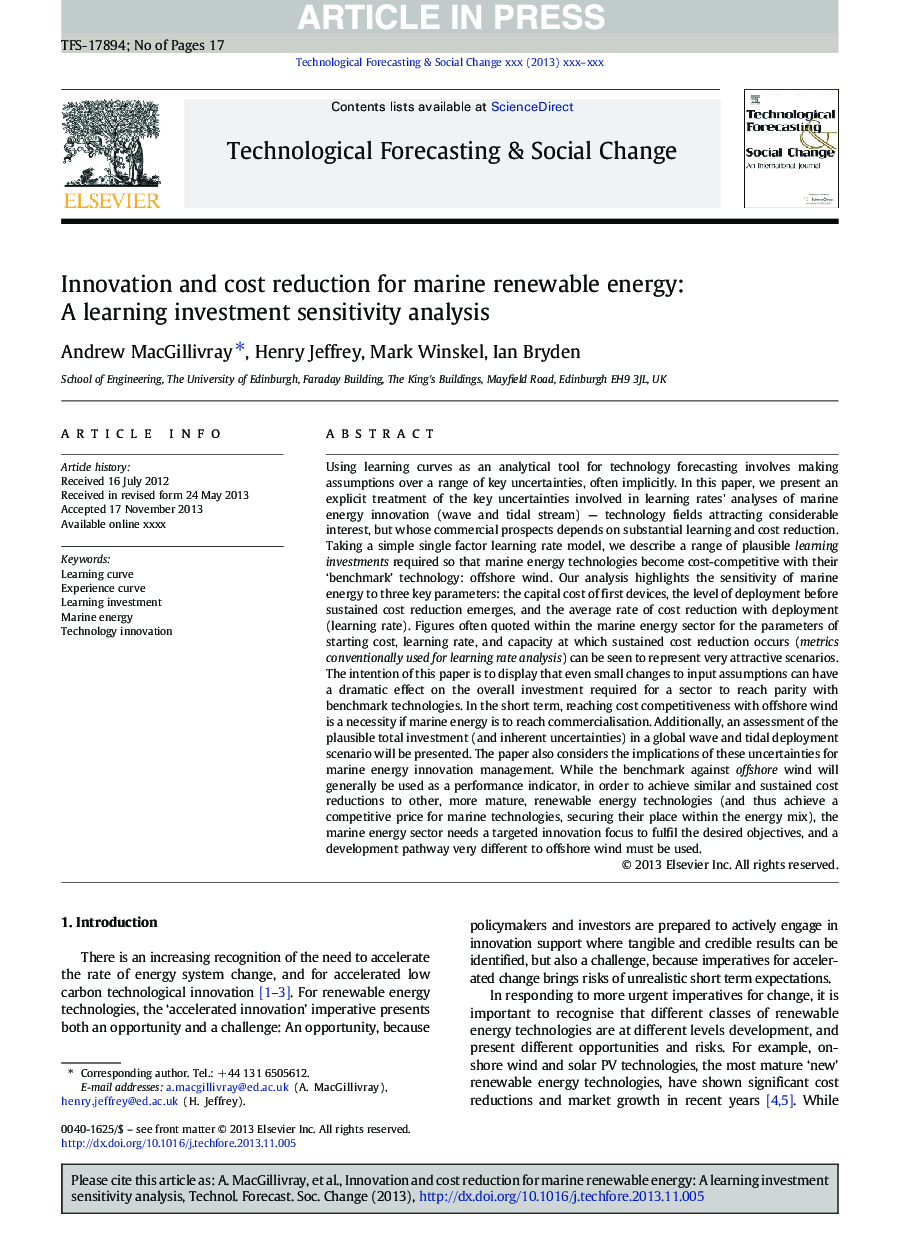| کد مقاله | کد نشریه | سال انتشار | مقاله انگلیسی | نسخه تمام متن |
|---|---|---|---|---|
| 7257166 | 1472413 | 2014 | 17 صفحه PDF | دانلود رایگان |
عنوان انگلیسی مقاله ISI
Innovation and cost reduction for marine renewable energy: A learning investment sensitivity analysis
ترجمه فارسی عنوان
نوآوری و کاهش هزینه برای انرژی های تجدید پذیر دریایی: تجزیه و تحلیل حساسیت سرمایه گذاری یادگیری
دانلود مقاله + سفارش ترجمه
دانلود مقاله ISI انگلیسی
رایگان برای ایرانیان
کلمات کلیدی
منحنی یادگیری، منحنی تجربه، سرمایه گذاری آموزشی انرژی دریایی، نوآوری فناوری،
ترجمه چکیده
با استفاده از منحنی یادگیری به عنوان یک ابزار تحلیلی برای پیش بینی فناوری، گمانه زنی ها در مورد طیف وسیعی از عدم اطمینان کلیدی صورت می گیرد. در این مقاله، یک روش صریح از عدم اطمینان کلیدی مربوط به تجزیه و تحلیل نرخ یادگیری نوآوری انرژی دریایی (موج و جریانهای جزر و مد) - زمینه های فناوری که منافع قابل توجهی را جذب می کنند ارائه می دهند اما چشم انداز تجاری آنها به یادگیری و کاهش هزینه بستگی دارد. با در نظر گرفتن یک مدل ساده مدل نرخ یادگیری ما، ما طیف وسیعی از سرمایه گذاری های یادگیرنده قابل قبول را توصیف می کنیم تا فناوری های انرژی دریایی با تکنولوژی "معیار" خود رقابت کنند: باد ساحلی. تجزیه و تحلیل ما حساسیت انرژی دریایی به سه پارامتر کلیدی را نشان می دهد: هزینه سرمایه های دستگاه های اول، میزان استقرار قبل از کاهش پایدار هزینه ها و نرخ متوسط کاهش هزینه با استقرار (نرخ یادگیری). ارقام اغلب در بخش انرژی دریایی برای پارامترهای شروع هزینه، نرخ یادگیری و ظرفیت که در آن کاهش هزینه های پایدار صورت می گیرد (معیارهای مورد استفاده برای تجزیه و تحلیل میزان یادگیری) به طور معمول برای نشان دادن سناریو های بسیار جذاب دیده می شود. هدف این مقاله نشان دادن آن است که حتی تغییرات کوچکی در فرضیات ورودی می تواند تاثیر قابل توجهی بر سرمایه گذاری کلی مورد نیاز برای یک بخش برای دستیابی به برابر با فن آوری های معیار داشته باشد. در کوتاهمدت دستیابی به رقابت هزینه با باد دریایی ضروری است اگر انرژی دریایی برای رسیدن به تجاری سازی باشد. علاوه بر این، ارزیابی کل سرمایه گذاری قابل اعتماد (و عدم اطمینان ذاتی) در یک موج جهانی و سناریوی استقرار جزر و مد ارائه خواهد شد. این مقاله همچنین به بررسی این عدم قطعیت ها برای مدیریت نوآوری انرژی نوین می پردازد. در حالی که معیار ارزیابی در برابر باد دریایی به طور کلی به عنوان یک شاخص عملکردی به منظور دستیابی به کاهش هزینه های مشابه و پایدار به دیگر فن آوری های انرژی تجدید پذیر، بالغ، و به همین ترتیب دستیابی به قیمت رقابتی برای فن آوری های دریایی، تامین مکان خود را در انرژی مخلوط)، بخش انرژی انرژی دریایی نیاز به تمرکز نوآوری هدفمند برای رسیدن به اهداف مورد نظر دارد و باید مسیر توسعه بسیار متفاوت با باد دریایی استفاده شود.
موضوعات مرتبط
علوم انسانی و اجتماعی
مدیریت، کسب و کار و حسابداری
کسب و کار و مدیریت بین المللی
چکیده انگلیسی
Using learning curves as an analytical tool for technology forecasting involves making assumptions over a range of key uncertainties, often implicitly. In this paper, we present an explicit treatment of the key uncertainties involved in learning rates' analyses of marine energy innovation (wave and tidal stream) - technology fields attracting considerable interest, but whose commercial prospects depends on substantial learning and cost reduction. Taking a simple single factor learning rate model, we describe a range of plausible learning investments required so that marine energy technologies become cost-competitive with their 'benchmark' technology: offshore wind. Our analysis highlights the sensitivity of marine energy to three key parameters: the capital cost of first devices, the level of deployment before sustained cost reduction emerges, and the average rate of cost reduction with deployment (learning rate). Figures often quoted within the marine energy sector for the parameters of starting cost, learning rate, and capacity at which sustained cost reduction occurs (metrics conventionally used for learning rate analysis) can be seen to represent very attractive scenarios. The intention of this paper is to display that even small changes to input assumptions can have a dramatic effect on the overall investment required for a sector to reach parity with benchmark technologies. In the short term, reaching cost competitiveness with offshore wind is a necessity if marine energy is to reach commercialisation. Additionally, an assessment of the plausible total investment (and inherent uncertainties) in a global wave and tidal deployment scenario will be presented. The paper also considers the implications of these uncertainties for marine energy innovation management. While the benchmark against offshore wind will generally be used as a performance indicator, in order to achieve similar and sustained cost reductions to other, more mature, renewable energy technologies (and thus achieve a competitive price for marine technologies, securing their place within the energy mix), the marine energy sector needs a targeted innovation focus to fulfil the desired objectives, and a development pathway very different to offshore wind must be used.
ناشر
Database: Elsevier - ScienceDirect (ساینس دایرکت)
Journal: Technological Forecasting and Social Change - Volume 87, September 2014, Pages 108-124
Journal: Technological Forecasting and Social Change - Volume 87, September 2014, Pages 108-124
نویسندگان
Andrew MacGillivray, Henry Jeffrey, Mark Winskel, Ian Bryden,
